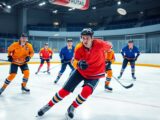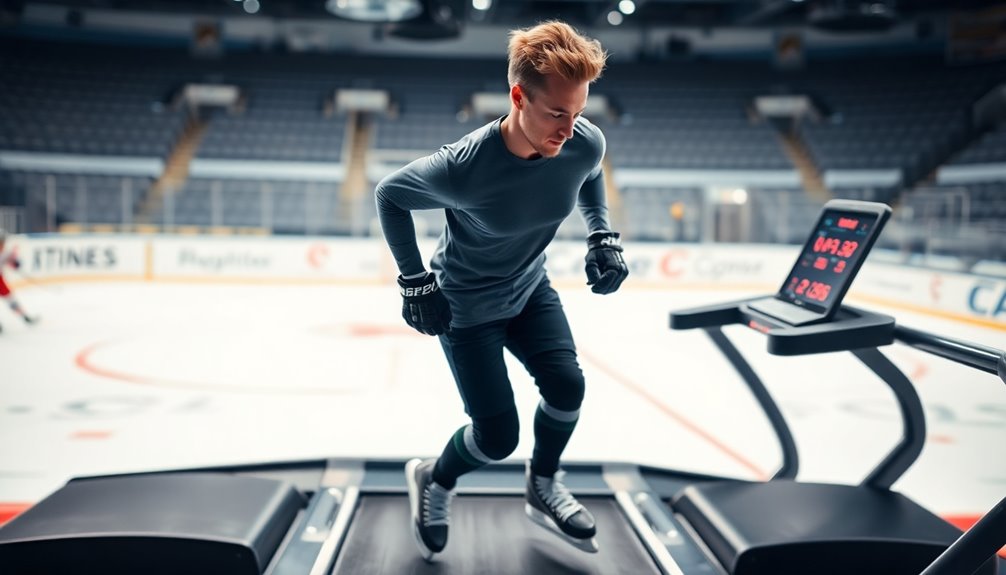
How to Use a Hockey Treadmill to Maximize Performance
December 26, 2024To maximize your performance on a hockey treadmill, start with a proper warm-up, like a 5-minute walk, to prepare your body. Incorporate interval training that targets your alactic, lactic, and aerobic energy systems, focusing on sprints and longer runs. Adjust the incline for reduced impact and increased power output. Monitor your heart rate to guarantee you're training at the right intensity. Don't forget to emphasize recovery techniques, proper nutrition, and hydration to support your training. Stick with it, and you'll see significant improvements in your skating technique and overall performance as you continue to train smart.
Benefits of Treadmill Training
Treadmill training offers numerous benefits that can greatly enhance your hockey performance. By improving cardiovascular fitness, you increase your oxygen supply, which is vital for sustained on-ice action. A stronger cardiovascular system boosts your cardiac output and vascular network density, allowing you to keep up the pace during intense games. Incorporating long-distance running into your treadmill sessions can further enhance your aerobic base, which is crucial for maintaining endurance during games. Additionally, effective conditioning techniques can significantly improve your overall athletic performance.
When you incorporate incline work into your skating treadmill sessions, you can reduce joint impact while simultaneously increasing your power output. This makes it an effective method for hockey training, enhancing your explosive speed without putting excess strain on your body.
Utilizing controlled intervals on the treadmill allows you to target different energy systems—alactic, lactic, and aerobic—tailored specifically to the demands of hockey. This specificity guarantees you're well-prepared for the varied intensity of a game.
Additionally, treadmill workouts are excellent for maintaining your conditioning when outdoor access is limited, whether due to weather or a busy schedule.
Consistent high-intensity treadmill sessions can lead to significant improvements in your skating speed, agility, and overall performance on the ice. Embrace treadmill training to elevate your game to new heights! Furthermore, integrating endurance training methods into your routine can further enhance your stamina and readiness for high-intensity activities on the ice.
Essential Warm-Up Techniques
Before you hop on the hockey treadmill, a proper warm-up is essential for maximizing your performance and minimizing the risk of injury. Start with a 5-minute speed walk to elevate your heart rate and prepare your muscles for the intensity to come. This simple warm-up routine sets the stage for a successful workout. Incorporating Pain Shuttles Drill into your training can further enhance your cardiovascular endurance.
Next, incorporate dynamic stretches that target your hips, legs, and core. These stretches enhance mobility and flexibility, both vital for ideal skating skills on the treadmill. Consider adding sport-specific movements like lateral shuffles and high knees. These exercises mimic skating mechanics, improving your neuromuscular activation and getting your body in sync. Additionally, engaging in speed and agility drills can further improve your overall performance on the ice.
To further activate your lower body muscles, include light resistance exercises such as bodyweight squats or lunges. This will prepare your legs for the powerful strides you'll need during your treadmill session. Additionally, ensure you engage in a gradual cool down after your workout to enhance recovery and minimize soreness.
Effective Treadmill Workouts
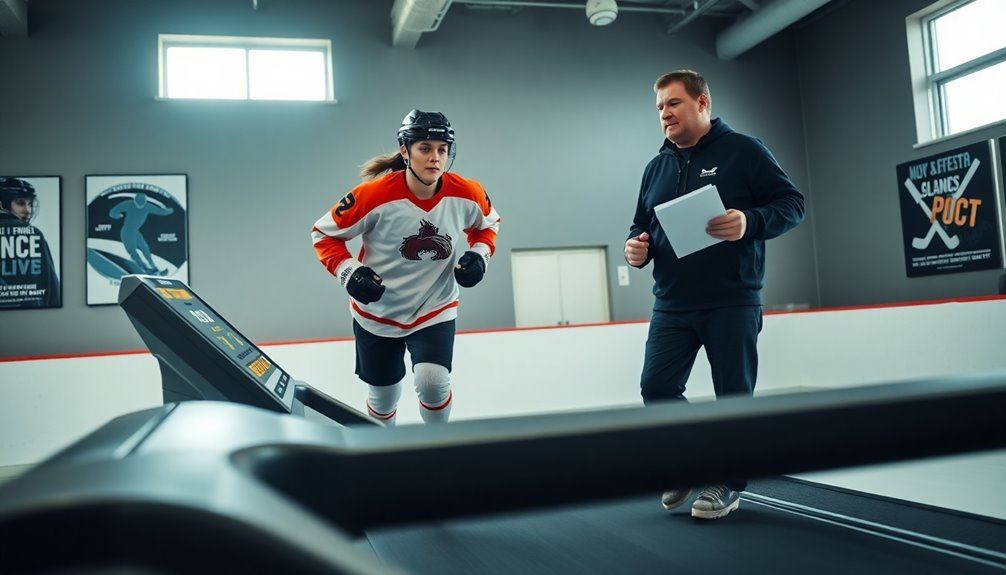
An effective workout on a hockey treadmill can greatly boost your on-ice performance and endurance. To maximize your training, structure your treadmill workouts into intervals. For instance, alternate between 60 seconds at 90% of your maximal output followed by 2 minutes of rest. This method enhances your conditioning and stamina, mimicking the demands of a hockey game. Incorporating running for stamina and speed can also be beneficial, as it develops the endurance needed for sustained performance. Additionally, utilizing sprint and agility drills during your workouts can further enhance your response to game situations.
Incorporating incline during your sessions can simulate hill sprints, increasing your power output while minimizing joint impact. This approach makes your workouts both effective and safer.
Short, intense sessions, like 15-minute workouts that combine steady state and high-intensity intervals, can deliver maximum benefits while reducing strain on your body.
Utilizing the Rate of Perceived Exertion (RPE) allows you to tailor the intensity of your treadmill workouts, ensuring you're pushing yourself according to your fitness level.
Additionally, consistently applying workouts that challenge different energy systems leads to significant improvements in cardiovascular fitness and overall performance on the ice. Incorporate speed and agility development into your training regimen to further enhance your performance on the ice.
Combining Strength and Conditioning
Combining strength training with your hockey treadmill workouts can greatly enhance your on-ice performance. By developing the muscular strength necessary for powerful strides and effective puck handling, you'll find yourself performing at a higher level. Incorporating core strength exercises during your treadmill sessions boosts your balance and stability, allowing you to maintain control during those high-intensity skating moments. Additionally, integrating strengthening exercises into your routine can improve your overall power and speed on the ice.
You can maximize your conditioning by utilizing treadmill intervals alongside strength exercises. This approach helps you adapt to the demands of on-ice play, ensuring you're prepared for every game situation. Alternating between strength training and treadmill workouts is key; it develops both explosive power and endurance, which are vital for sustaining your performance throughout all three periods. Structured off-season strength training programs that integrate treadmill conditioning can lead to significant improvements in your skating speed and agility.
As you build these attributes, you'll notice a marked enhancement in your overall performance on the ice. Moreover, focusing on technical skills will further complement your training regimen, making you a more well-rounded player.
Understanding Energy Systems
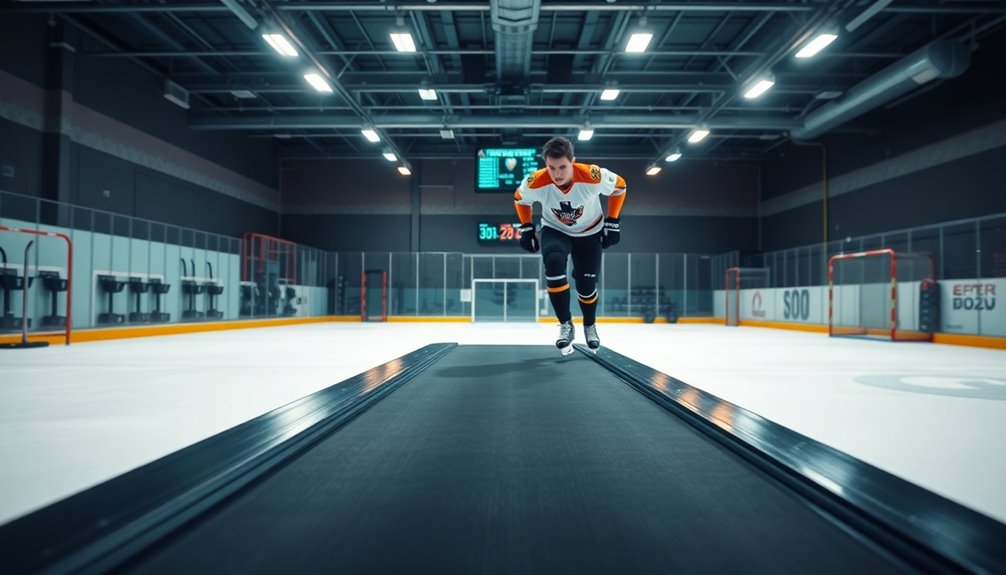
To maximize your performance on the ice, you need to understand the three primary energy systems used in hockey: alactic, lactic, and aerobic.
Each system plays a vital role during different phases of a game, influencing your training focus on power, endurance, or overall fitness. Developing technical skills through targeted drills can enhance your efficiency in utilizing these energy systems effectively. Additionally, incorporating proper nutrition into your training regimen can further support your energy system development and overall performance. Understanding the importance of sportsmanship and respect can also improve your team dynamics and overall game strategy.
Energy System Overview
Understanding how energy systems work is essential for maximizing your hockey training. There are three primary energy systems you'll utilize: the alactic system, the lactic system, and the aerobic system. Each system plays a critical role in your performance on the ice.
The alactic system supports maximum efforts lasting up to 12 seconds, focusing on explosive power and speed. This energy system is crucial during quick sprints or explosive plays.
The lactic system kicks in for efforts lasting 30 to 90 seconds, emphasizing endurance and sustained performance during gameplay, such as during prolonged shifts.
Finally, the aerobic system comes into play for submaximal efforts that last longer than 2 minutes, enhancing your cardiovascular fitness and helping maintain energy levels throughout longer shifts.
To optimize your training program, you can tailor protocols to emphasize specific energy systems based on the duration of your efforts and rest periods.
Monitoring your heart rate during training will help you effectively target these energy systems, ensuring your workouts align with your specific performance goals.
Training System Focus
Maximizing your training on a hockey treadmill requires a focused approach to the three energy systems: alactic, lactic, and aerobic. Each system serves a unique purpose in your performance enhancement and conditioning.
The alactic system is vital for short bursts of power, so you should incorporate 6-10 second sprints at maximum speed with complete recovery to boost your quick acceleration and explosive strength.
Next, focus on the lactic system for moderate endurance. Aim for high-intensity efforts lasting 30-90 seconds, which will help you sustain performance under fatigue during games. This training will enhance your muscular endurance, allowing you to push through those challenging moments on the ice.
Finally, don't neglect your aerobic system. Longer intervals of over 2 minutes on the treadmill will improve your cardiovascular fitness and oxygen supply, significant for maintaining performance throughout the game.
Performance Enhancement Strategies
When it comes to enhancing your performance on the ice, recognizing how each energy system works can make all the difference. As a hockey player, understanding the alactic, lactic, and aerobic systems is essential for optimizing your conditioning.
- Feel the rush of explosive speed during essential moments.
- Experience the thrill of outlasting your opponents in the final minutes.
- Enjoy the satisfaction of achieving your personal best on the ice.
The alactic system powers short bursts of energy lasting up to 12 seconds, so focus on high-intensity intervals with complete recovery.
For longer efforts, tap into the lactic system with intervals lasting 30-90 seconds, allowing you to build endurance.
Finally, develop your aerobic system with submaximal efforts exceeding 2 minutes, enhancing cardiovascular fitness and recovery rates.
Monitor your rest periods carefully; shorter breaks boost lactic capacity, while longer rests enhance alactic power.
By incorporating incline adjustments on the treadmill, you can also target stride rate and length, which will improve your explosive acceleration and top-end speed technique.
Embrace these strategies to elevate your game and outperform the competition.
Tailoring Workouts for Skill Levels
When it comes to tailoring workouts for skill levels, you'll want to focus on beginners honing their skating technique with repetitive drills. As you progress to advanced players, introduce conditioning challenges that push their limits and enhance performance. This approach guarantees that each athlete gets the most out of their training on the hockey treadmill. Additionally, incorporating team dynamics into training sessions can foster better communication and cooperation among players, which is vital for success on the ice.
Beginner Technique Focus
To build a solid foundation on the hockey treadmill, beginners should concentrate on mastering essential skating mechanics. Focusing on knee and hip flexion along with proper arm motion will help you establish a strong base for effective conditioning.
Start with high repetition skating sessions lasting 20-30 seconds. This approach enhances neuroplasticity, allowing young players aged 6-10 to rapidly learn motor patterns.
As you progress, keep these key points in mind:
- Feel the thrill of gliding smoothly across the treadmill.
- Experience the joy of mastering each new skating technique.
- Embrace the satisfaction of improving your conditioning and skills.
For players aged 11-14, shift to shorter, intense skating intervals at higher speeds. This develops your sprinting biomechanics and boosts your cardiovascular fitness, while also introducing mental control techniques.
Remember, tailoring your workouts to your specific skill level guarantees that your unique developmental needs are met. This targeted approach won't only enhance your skills but also foster sustained improvement in your performance on the ice.
Commit to refining your technique, and you'll see your confidence and abilities soar!
Advanced Conditioning Challenges
As players advance in their training, it's important to tailor workouts to match their evolving skill levels and physical capabilities. Younger players, ages 6-10, should focus on high repetition of fundamental mechanics through 20-30 second skating intervals during their treadmill workouts.
For older players, ages 15-18, explosive speed training is vital to enhance power and explosiveness.
Incorporate specific energy system training by utilizing short, intense intervals for the alactic system while reserving longer, sustained efforts for aerobic conditioning. These workouts should challenge limits but also allow for sufficient recovery.
Adjusting incline settings is significant; higher inclines can kickstart acceleration training, while lower inclines help refine top-end speed techniques.
Monitoring Rate of Perceived Exertion (RPE) scores guarantees that you're working within ideal intensity levels tailored to your fitness progress.
Providing immediate feedback during treadmill sessions helps refine technique, enhances movement efficiency, and minimizes injury risks.
Monitoring Progress and Intensity
Monitoring progress and intensity during hockey treadmill sessions is essential for maximizing training effectiveness. To achieve peak conditioning, you should utilize heart rate monitoring to guarantee you're training within your target zones. This way, you can push yourself while avoiding overexertion.
Implementing Rate of Perceived Exertion (RPE) scores allows you to assess workout intensity, helping you adjust efforts based on how you feel.
Keep a detailed record of your workouts, including duration, speed, incline, and recovery times. This tracking will help you identify patterns and measure improvements over time.
Consider incorporating interval training structures, which target different energy systems and enhance your performance metrics.
Remember, monitoring progress isn't just about numbers—it's about how you feel and improve. Keep these emotions in mind:
- The thrill of beating your personal best.
- The satisfaction of seeing your hard work pay off.
- The confidence boost from mastering your technique.
Regularly reassessing your skating technique guarantees that gains in speed and agility align with proper biomechanics, solidifying your path to success.
Nutrition and Recovery Strategies
Nutrition and recovery strategies play an essential role in optimizing your performance on the hockey treadmill. To maximize your results, focus on consuming a balanced meal rich in carbohydrates and protein within 30 minutes post-workout. This helps enhance glycogen replenishment and muscle recovery, ensuring you're ready for your next session.
Staying hydrated is also imperative—dehydration can impair performance and increase fatigue, so drink water before, during, and after your workouts.
Incorporate anti-inflammatory foods like berries, fatty fish, and leafy greens into your diet to reduce muscle soreness and speed up recovery times.
Don't underestimate the importance of sleep; aiming for 7-9 hours per night is crucial for muscle repair and cognitive function, both of which enhance your training effectiveness.
Lastly, consider active recovery strategies such as light skating or stretching after your treadmill workouts. This helps maintain blood flow to your muscles, promoting faster recovery.
Long-Term Performance Improvement
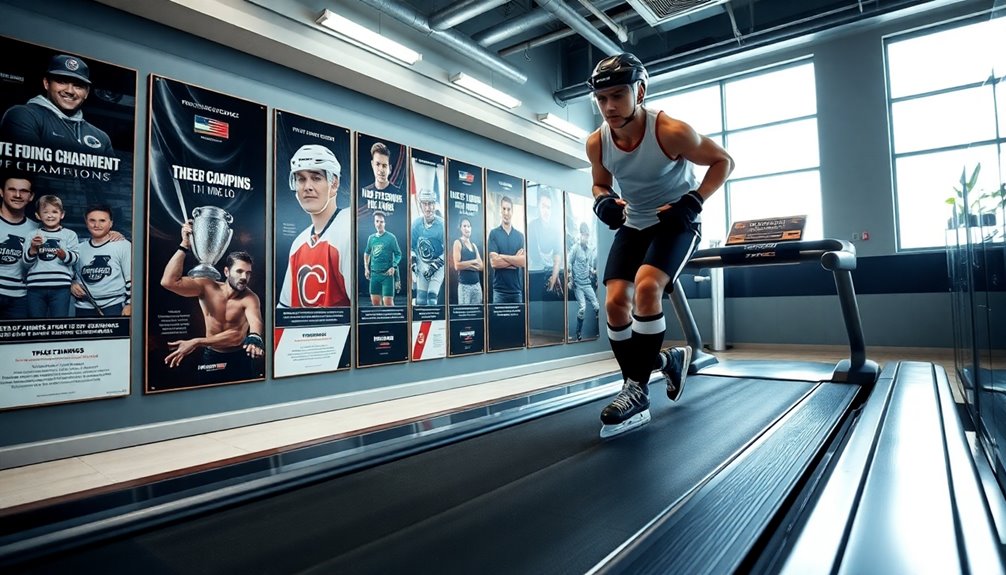
By prioritizing recovery and nutrition, you're setting the foundation for long-term performance improvement on the hockey treadmill. Regular use of this specialized equipment not only enhances your skating mechanics but also boosts your cardiovascular endurance. This leads to improved on-ice performance and reduced fatigue during games.
Incorporating targeted interval training on the treadmill conditions your energy systems, promoting faster recovery and sustained speed throughout all three periods of play. Plus, the immediate feedback you receive on your technique allows for critical adjustments, helping you prevent injuries and become more efficient on the ice.
To truly harness the benefits of the hockey treadmill for long-term athletic development, consider these points:
- Feel the exhilaration of seamless skating, free from fatigue.
- Experience the thrill of outperforming your competition in critical moments.
- Enjoy the satisfaction of witnessing your progress and growth over time.
Structured treadmill workouts align with the specific demands of hockey, ensuring your training remains relevant and effective.
Commit to regular sessions, and you'll reinforce foundational skills while allowing for progressive overload, paving the way for higher levels of competition.
Conclusion
Incorporating a hockey treadmill into your training can seriously boost your performance on the ice. Did you know that athletes who use treadmill training can improve their speed by up to 15%? By following the techniques and strategies outlined, you'll not only enhance your cardio and strength but also tailor your workouts to your skill level. Stay committed, monitor your progress, and don't forget to prioritize nutrition and recovery for long-term gains. Now, lace up and hit that treadmill!


